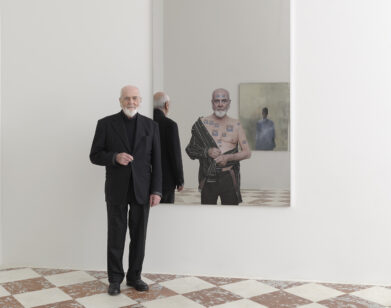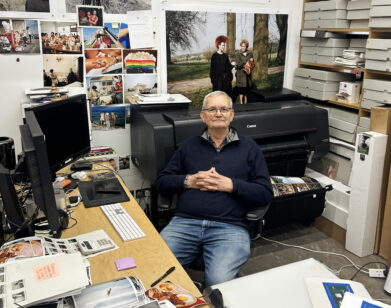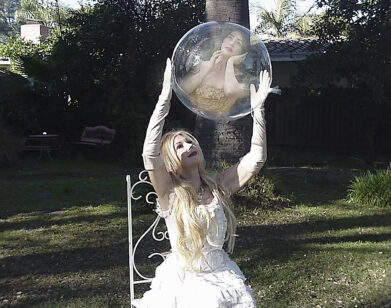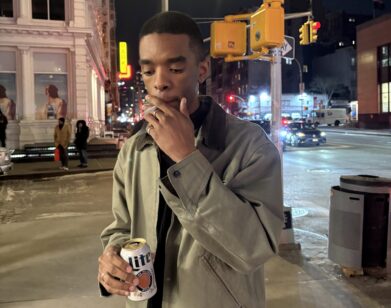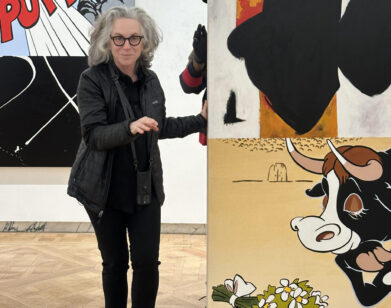Laurie Simmons On Display
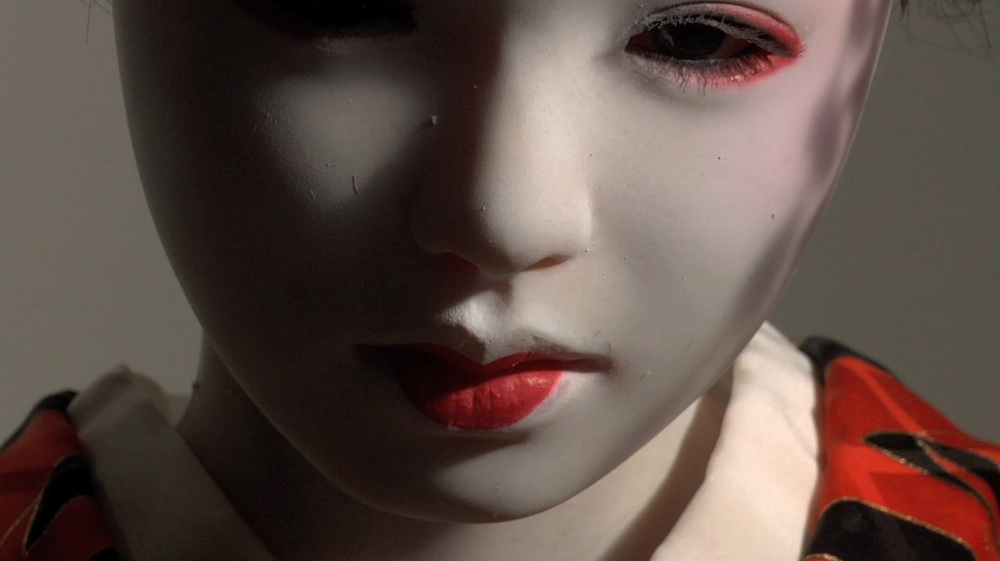
Since Laurie Simmons began showing her photographs in the ’70s, her colorful cibachromes of dolls in domestic settings, her surreal “object-on-legs” series (where gender-loaded imagery of houses, perfume bottles, birthday cakes, and guns are perched on comely stockinged legs), and more recently, her series of posed sex surrogate Japanese love dolls, have dissected the prescribed cultural iconography of womanhood.
Her latest works have taken Japanese kigurumi cosplay culture (where both men and women, known as dollers, don life-size latex doll outfits and huge, anime character-like heads and go out in public) as a starting point for an exploration of the psychology of identity, artifice, masking, and performative behavior.
Starting today, two of Simmons’ videos, Ringtone and Geisha Song, which she showed in conjunction with her recent show “Kigurumi, Dollers and How We See” this past spring at Salon 94, will be installed on all LED signage at The Cosmopolitan of Las Vegas resort as a part of “PAUSE,” The Cosmopolitan’s collaboration with public art nonprofit Art Production Fund.
Simmons, who is continuing to work on a series inspired by kigurumi, will be the subject of an exhibition at The Jewish Museum in New York next year, and will exhibit a series of her gun images (a “Warholian take,” she says) at the 94th Street location of Salon 94 in December, with proceeds benefitting New Yorkers Against Gun Violence.
We called her up last week from our office in SoHo. She was at home in Connecticut.

COLLEEN KELSEY: Is this your first time working on a piece of public art?
LAURIE SIMMONS: I have done public art projects before, I think I did a bus shelter project, but my film work and video work is something that is really important to me. I’ve never had an opportunity to really project my video work on this scale; to use my video work in a public space. The two videos that they’re going to show are things that I made for the window of Salon 94 to go with the bodies of work I was showing, so the idea that they’re going to be able to be accessed publically is really exciting.
I had a little bit of a chance to watch the video when Salon had it on the video wall outside the gallery. And people, as they walked by, I could see they touched their pockets, or started to reach for their phones. It’s always really confusing. Your ringtone is so personal to you, but the fact is millions of other people have your ringtone. I really love that connection, and call me crazy, but I find the iPhone ringtones super melodic and very danceable. [laughs]
KELSEY: Which one in particular?
SIMMONS: I think the one that I have is called “Seaside,” but I used all the ones that I really like. I’m really mesmerized by the ringtones that they come up with, and I don’t get tired of them. So the idea of being able to use them as a dance track was so cool. When I think about the artifice of the characters that I’m creating—the maskers—it’s sort of the perfect soundtrack for them. I’m going to tell you what my ringtone is, let me get my phone. It is “By The Seaside.” [laughs]
KELSEY: I have an iPhone too, but I’ve always avoided “Marimba,” which is sort of the standard one. It’s everywhere. I never know if someone is calling me because everyone has that ringtone.
SIMMONS: But it kind of turns out, since I’m sensitized to it, that everyone has everything. I used to have “Harp” because I thought that’s a gentle way to get bad news. But then “Harp” started to become full of anxiety for me because anything can turn, in terms of ringtone and what you associate with it. Your phone rings in the middle of the night and it’s not so soothing.
KELSEY: I really love the dancing in the video. It’s electric and flirtatious and provocative when she’s showing the underside of her skirt and the slip. Contextualized in the Las Vegas environment, do you have any expectation for how the video can potentially transform people who are maybe there for vacation, or some sort of debauchery?
SIMMONS: I don’t. I know I’m not alone in this as an artist, but we make work for lots of reasons. Unlike in the film world, I try not to imagine who my audience is. I’ll never know where it comes from or who it is, or who will stop, look, and listen. That’s just the way it goes. But what I love in this context, and this is so true of so much art because there’s so much crossover to fashion and digital media and social media, I just wonder at what point people realize that something different is being delivered to them through that particular delivery system. I’m curious about the point where they realize it’s not an ad, it’s not a trailer, it’s not a teaser for a movie, it’s not a fashion shoot, so what is it? That’s as much as I can imagine, somebody stopping and figuring out that it might not have a message that they’re used to. Beyond that I can’t imagine what people would do with it. In the case of Ringtone, probably they’ll just be amused and walk on. I just don’t know. I’m showing Geisha Song too. They’re so different. That’s kind of interesting to imagine.
KELSEY: Are you continuing to work with kigurumi culture right now?
SIMMONS: Sort of, it’s a lot my own brand. Kigurumi culture was a place for me to take off and enact some of my own fantasies of dolls and humans merging into one other kind of creation. It’s kind of the first time I could ever comfortably work with a human when I found these masks that the so-called dollers wear. It’s the first time that I wasn’t really struggling with finding the right doll, or setting it up, or how does it stand, and what’s the scale? Suddenly, it’s like a doll whose comes to life and has its own agenda. I can direct up to a certain point, but beyond that, this human is going to do what it wants to do. There were two photos in the Kigurumi doller show that were called How We See. They were models that have realistic eyes painted on their closed eyelids; I’m continuing that. I’m showing the new pictures at The Jewish Museum in March; it will be a continuation of the How We See pictures.
KELSEY: And those photos were an outgrowth of your interest in the women who have plastic surgery to emulate Barbies?
SIMMONS: Yeah. It seemed like in my exploration of anime and what people were up to, there were girls on YouTube who were giving demonstrations of how to paint these anime eyes on their own lids. And I just thought, God, that’s so beautiful and eerie, and who would ever think that up? My own version is a little more realistic and maybe the gaze is a little bit more searing, but I think it speaks to so many things, and also has a dialogue with all the work I’ve ever done, from ventriloquism, to objects on legs, to the kigurumi pictures with their really big eyes. It resonates really deeply for me, and I really love making the pictures.
KELSEY: When did you realize that dolls could be a useful tool for the artwork you wanted to make? I read that you never liked dolls as a kid growing up.
SIMMONS: Probably when I started taking pictures and I was taking pictures of really small black-and-white rooms, wondering if they could be mistaken for real rooms. I was really engaging with photography on the level of its inherent ability to tell lies, not to tell the truth, and also trying to circle around it as an ambiguous medium, as an ambiguous storyteller. Pictures as an ambiguous example of the truth. Then, when I needed to populate those rooms of small-scale furniture, it was logical that I would grab dolls as stand-ins. But, just to address your other question, I was just sort of too much of an ADHD, frenetic kid to ever sit down and really work it out with dolls.
KELSEY: I feel like there are definitely two camps of girls who are either really attached to their dolls, or who absolutely detest them and will deface them.
SIMMONS: I think that’s so true. Then of course there’s a third group that are obsessed with horses. I always had my eye on those girls. [both laugh] They could draw horses really well and I had absolutely no feeling toward horses. I was definitely in the defacing group.
KELSEY: You’ve been working with issues of gender and female agency since you first started making work, but do you feel like the issues that you’ve approached since the beginning of your career have changed significantly? Have they stayed the same, or have they adapted to the moment?
SIMMONS: They’ve absolutely adapted to the moment, and absolutely stayed the same. Both. There’s so much to do. The language may be different, the issues may be slightly skewed. It’s so hard to talk about, because things are both shockingly different and shockingly the same. And issues that young women have are issues that I can really relate to. The language may be different but I’m not too old to learn. [laughs] What makes me happy is there’s so many more voices. I feel like were in a period where a lot of young women are really speaking up and not afraid to call themselves feminists, and that’s pretty cool.
KELSEY: Do you think that the way you’ve approached these issues in your own work has changed significantly?
SIMMONS: Well, I think that I’m an image scavenger. I really find what’s around me. So if somebody had told me in the late ’70s that I could get this incredible mask that looked like a doll for a human to wear, who knows what would’ve happened. I might have done it and stopped taking photographs then. I continue to be able to feed the hungry beast that allows me to make work by digging around the culture and see what’s being served up. Just spending a lot of time in Japan and understanding the visual side of Japanese culture was huge for me. In a way, their visual representation of life is somewhat infantilized, and that works really well for me. That’s a place I could really live. I mean, I live in New York, but I could creatively live there. There’s so much inspiration for me there.
PAUSE-LAURIE SIMMONS IS ON VIEW STARTING TODAY AT THE COSMOPOLITAN OF LAS VEGAS

